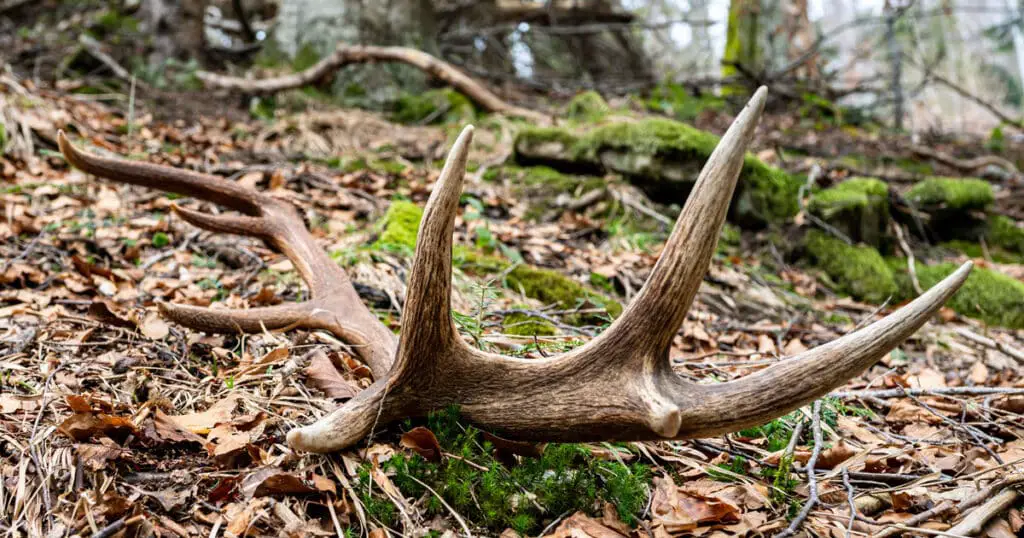We’ve all heard of deer hunting, but what about shed antler hunting? It’s the process of searching for shed deer antlers in the wild. Deer shed their antlers every year, and many people enjoy searching for sheds and using them for a variety of purposes. Keep reading to learn how you can get involved in this popular outdoor activity.
To be a successful shed antler hunter, you’ve got to know where and how to find them, when to look, and more.
That’s exactly what we’ll explore here. Here’s an overview of this essential guide:
- The basics of shed antler hunting
- How to find shed antlers
- When to hunt for shed antlers
- Where to find shed antlers
- Moose shed antler hunting
- Elk shed antler hunting
- Should you get a shed antler dog?
- What to do with shed antlers once you find them
Shed Antler Hunting: The Basics
Table of Contents
ToggleYou should usually look for shed antlers between February and March each year. Depending upon where you live, you may also find antlers earlier, even in early January.
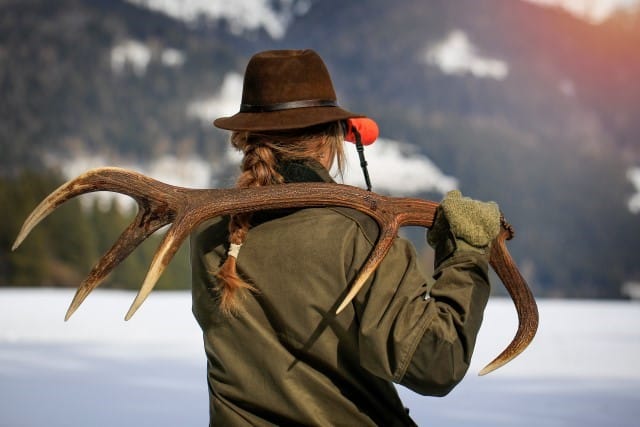
Places to look for shed antlers include deer bedding areas, feeding areas, and travel corridors.
It all depends on where deer in your area are shedding and leaving their antlers each year.
There are different techniques for finding the antlers. Let’s dig a little deeper and explore the subject more fully.
How to Find Shed Antlers
As we touched on earlier, bedding areas, travel corridors, water sources, and feeding areas are great places to look for shed antlers. To find bedding areas, look for places that have excellent cover and foliage.
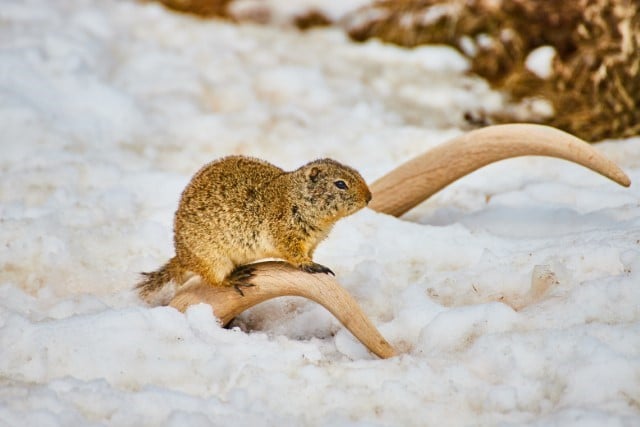
Deer bedding areas are where these animals spend time sleeping, relaxing, and enjoying cover from predators. As deer spend so much time in their bedding areas, there’s a strong chance you will find antlers there.
Finding sheds may sound easy, but it can be a challenging activity if you don’t know how to do it. Here are helpful tips for finding antlers in the woods.
- Choose the right times of day
- Frequent the same areas
- Walk slowly
- Use binoculars
- Check fence lines
Let’s explore each of these tips in detail below.
Choose the Right Times of Day
The best times of day for shed hunting tend to be at the same times you’d have most success hunting deer. The morning at dawn and the evening at dusk tend to be the times when deer are most active, and can be good times to look for sheds.
Too much sunlight, especially if it’s in front of you, may make it more difficult to see the white of shed antlers. Ideally, you should keep the sun at your back when looking for antlers.
Frequent the Same Areas
If you’ve found lots of sheds in a particular spot, go back several more times. More deer will probably come to shed their antlers there.
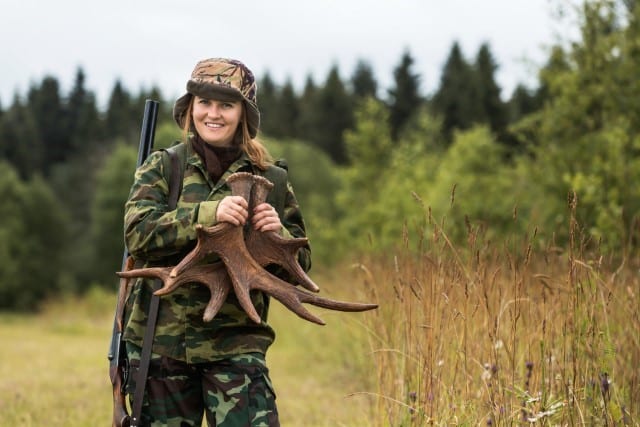
All bucks don’t shed their antlers at exactly the same time each year. Some may shed their antlers very early, while others will wait until later.
Walk Slowly
Antlers can be pretty tricky to spot. Walk slowly and only cover one limited area at a time.
As you walk, look everywhere around you, near your feet and at a distance, to see if there are antlers on the ground.
Use Binoculars
Binoculars always come in handy during shed antler hunting expeditions. After all, antlers are difficult to spot from a distance, but with a good set of binoculars, you can scan open spaces in short order.
Check Fence Lines
Deer often jump fences and when they do this, loose antlers are likely to fall. This is why it’s pretty common to find shed antlers near fences.
If there are any fences in the areas where deer live in your area, always look alongside them. There are probably antlers waiting there for you.
When Deer Shed Their Antlers
Most white-tailed deer shed hunters go out on the trail in March and April. Find out whether your region has a designated season for shed antler hunting.
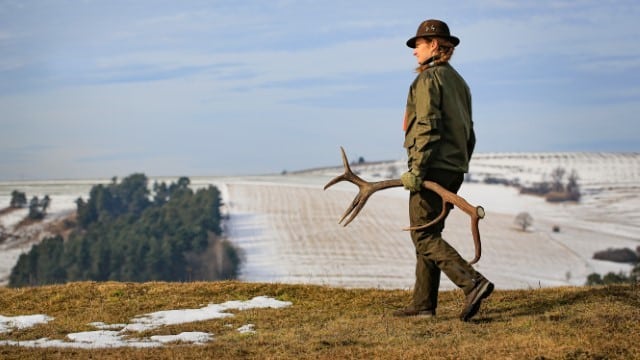
February through March is the time of year when most deer shed their antlers. As we touched on earlier, though, some bucks drop their antlers earlier, even in January.
This pattern is true for most populations of whitetail deer around the United States. Most male deer will have shed their antlers by the time early April arrives.
These regulations are sometimes put in place to cut down on the number of people in the woods and the potential stress they put on animals in the area.
Avoid going shed antler hunting in the depths of the winter. Doing so may cause extra stress on deer that are already dealing with the difficulties of surviving in the cold and snowy weather.
At the same time, you shouldn’t wait too late in the year to find shed antlers either. Rodents are often attracted to antlers, and this can lead to irreparable damage.
Where to Find Shed Antlers
One of the most common places to find sheds are deer sleeping areas, otherwise known as bedding areas.
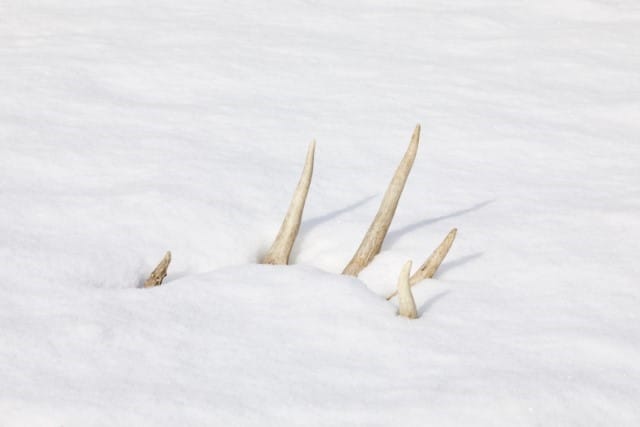
Even though deer are able to keep up a certain level of alertness even when sleeping, they need good cover and camouflage when they’re getting rest, relaxing, and grooming.
This is why you should look for areas with great cover that are far away from humans. These are most likely to be deer bedding areas.
Deer groom in these areas, so they’re especially likely to have some antlers during the right time of year.
Hunting Deer Shed Antlers
Some people enjoy hunting for sheds alone, but if you’re like most, you’ll want to take a group expedition.
This means there will be more eyes to spot antlers and it’s just a fun activity to enjoy with friends. Shed hunting is also an opportunity for exercise in the fresh air.
It can be a great way to spend time in the woods with your kids and family.
Moose Shed Antler Hunting
If you live and hunt in a region or a state with moose, you can search for moose antlers the same way you look for whitetail sheds. Remember, however, that moose antlers are simply enormous and palmate.
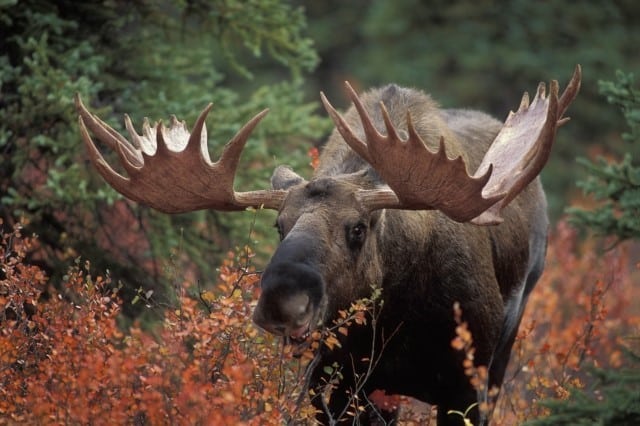
Some of the places where you may find shed moose antlers include higher elevations. For example, you may be more likely to find them in areas where there are mountain ash, striped maple, birch, spruce, and fir trees.
Look in areas with dense cover when hunting for moose sheds. These are the places where moose are likely to be spending most of their time in the winter.
As a consequence, this is where they are likely to have dropped their antlers.
Like whitetail deer, moose antlers fall off in the late fall to winter, and then they grow back in the spring and summer months.
Moose shed their antlers between November and March each year. Therefore, that is the time of year when you have a chance of finding shed moose antlers.
Older moose usually lose their antlers earlier, while younger ones lose them later.
Remember that like whitetail antlers, moose antlers may be a target for mice and other animals looking to chew on a good calcium source.
You should usually start your moose antler hunting as soon as the snow on the ground melts. If you wait too long to search for antlers, you may find them damaged.
And be alert – Moose may not be looking for a reason to attack humans, but they are large, powerful animals and can be unpredictable if spooked.
Elk Shed Antler Hunting
Elk antlers are much bigger than whitetail antlers, so be aware of that before you start looking for them. In general, finding elk antlers is a bit more challenging than finding whitetail sheds.
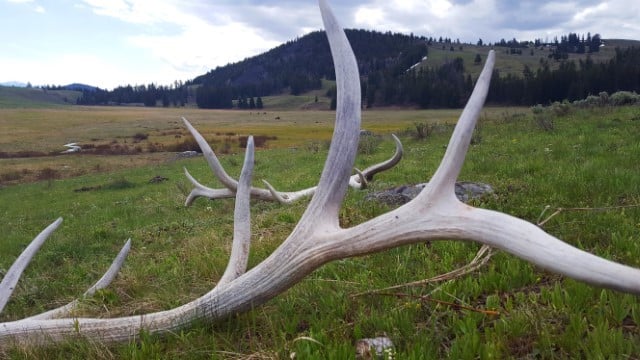
Of course, you must look in a region where elk live, and we have an article sharing data on the elk population by state which may help you with that.
Many elk shed hunters start their search by looking for the animals before they have actually lost their antlers. That way they can keep track of the animal’s movements.
This makes it much easier to find the antlers once they are dropped.
Elk usually shed their antlers between March and April each year. Older male elk usually shed their antlers earlier in that range than younger animals.
Keep a close eye on everything around you on the ground as you’re walking and looking for elk sheds. You should also use binoculars.
Should You Get a Shed Antler Dog?
Maybe you’ve heard others people talking about using shed antler dogs to help them in their antler hunt. While these canines may be somewhat helpful, they’re not quite as useful as once thought.
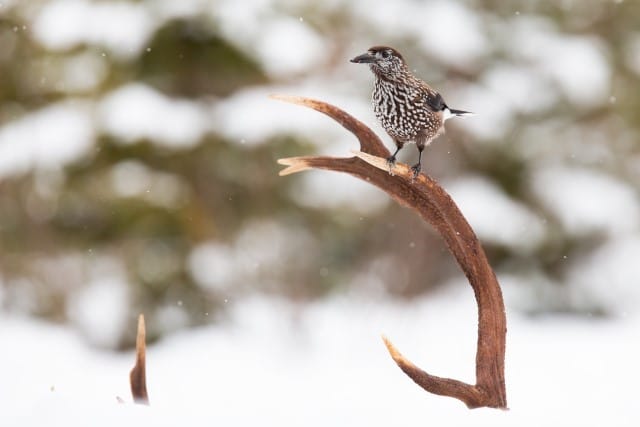
A shed antler dog is trained to find and retrieve antlers, bringing them back to their owner. For a shed antler dog to be effective, you will need to train it properly.
If you really want to use a shed antler dog, you can. But going to the trouble of training a dog to find and retrieve antlers may not be worth your while unless it’s your business.
Training a Dog to Find and Retrieve Shed Antlers
If you’re determined to have a shed antler dog, however, you will need to know how to train it. Also, there are only certain dog breeds that can be trained for this purpose. These include labs, retrievers, pointers, setters, and spaniels.
While it’s not difficult to train a dog to be a shed antler dog, it does take some patience. Just proceed in small steps.
Start off in small areas, hiding antlers in an easy-to-find position and encouraging your dog to find them. Once it has found them, give your canine lots of praise and positive reinforcement.
You want to make your dog acquainted with the shape and smell of antlers. Your dog also needs to understand that he must bring the antlers to you.
It’s not going to help you if your pooch thinks the antlers are a toy for him to chew and keep for himself.
What to Do With Shed Antlers Once You Find Them
So, why would you want to find antlers? Well, it’s because there are plenty of things you can do with antlers when you find them in the woods.
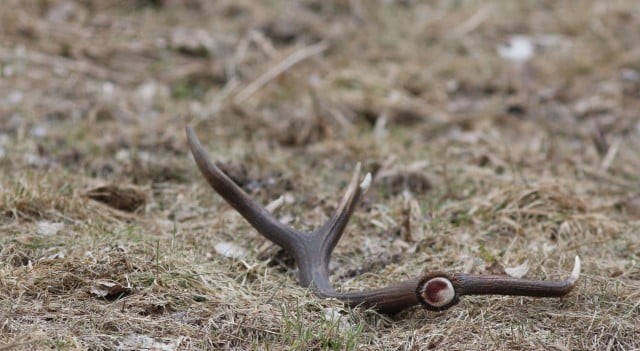
Here’s our list of what you can do with shed antlers:
Market and Sell Shed Antlers
You can market your antlers to collectors, as well as to people who like using deer antlers as a feature of their home décor.
When it comes to selling to collectors, know the value of your sheds before you sell. You’d be amazed at how much an enthusiastic collector will pay.
There are different value levels for various kinds of antlers. For example, you may get between $6 and $8 per pound for recently shed whitetail antlers.
Antlers that are too white and have a chalky look, however, may just get between $1 and $3 per pound.
Some antlers with a high value include brown mule deer sheds. If you find these, you may enjoy a price of approximately $10 per pound.
When it comes to brown elk antler sheds, you may get around $12 per pound.
Be Creative
You can also take on some DIY crafting projects using shed deer antlers.
For example, you can carve antlers into knife handles and buttons. If you want to carve deer antlers, you will probably need a Dremel tool set.
Some people carve antlers into home decor items, such as small decorative pieces. You can even make chandeliers and lamps.
It’s also fashionable to use deer antlers as an element in bookends and centerpieces.
Examine the Antlers
Examining shed deer antlers can tell you a lot about the deer they came from.
For example, you can gain greater insight into deer behavior. If you’re a deer hunter, this is valuable information.
You can put your new knowledge to work when creating strategies for the next hunting season.
Be a Collector
Some people enjoy collecting deer antler sheds. If you want to take up this hobby, you will have to know how to find sheds.
How to Sell Shed Deer Antlers
As shed deer antlers are no longer attached to the animal’s skull, you shouldn’t have any legal problem selling them.
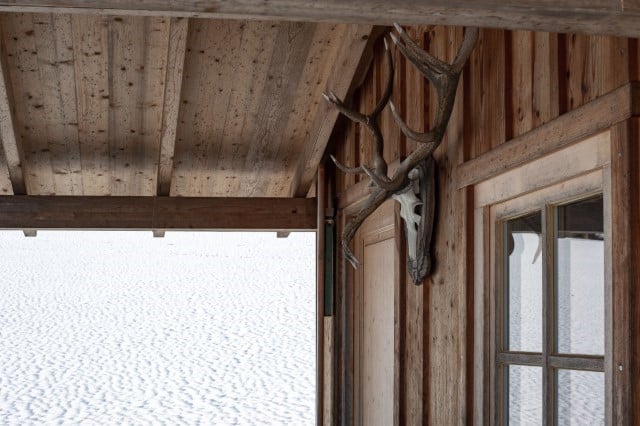
If you’re a deer hunter, be aware that your state may have laws and regulations about the sale of antlers you obtained through killing the animal.
If you want to sell your shed deer antlers, you should usually stick to selling them to someone you know who lives in your area. This way prospective buyers can see what you’re selling and verify that they are sheds.
Final Thoughts On Shed Antlers
Shed antler hunting is a popular activity in rural areas across the United States. It’s a fantastic way to spend time with family and friends in the great outdoors and with a little practice you can build up a fantastic collection of shed antlers.
If you enjoy crafting, look into beautiful artistic creations you can make with shed antlers. We have published an article dedicated to creative ideas for deer antlers. Take a look at it to get inspired!

